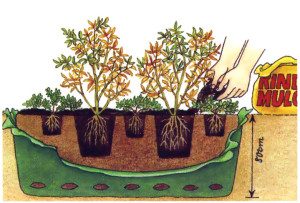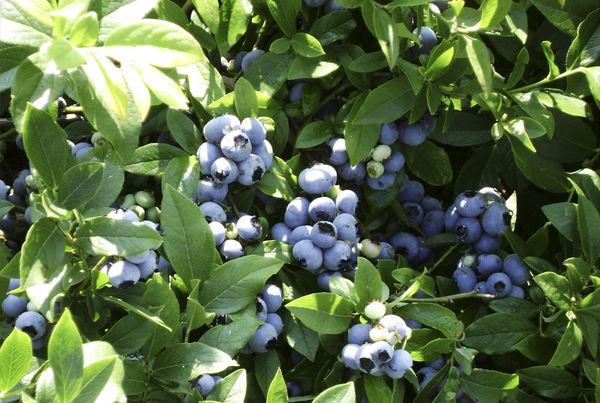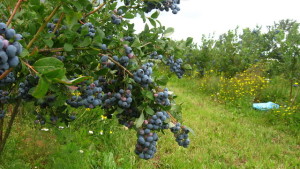Growing blueberries in the country - secrets and tips
Blueberry is a common shrub in Central Europe that is rapidly gaining popularity in Russia, Ukraine, Belarus and other neighboring countries. Since its berries have exceptional beneficial properties - a high content of vitamin C and other minerals and vitamins, it is essential in the diet of every healthy person. However, many summer residents refuse to grow it just because they do not know how to grow blueberries correctly. Although this shrub is not at all whimsical to care for and does not require much effort, only a few nuances need to be observed when growing blueberries.
Growing conditions
Industrial cultivation of blueberries is carried out only on acidic soils. The plant develops well on sandy and sandy loam substrates, peat bogs. To significantly improve the water regime and soil fertility, rotted deciduous litter is used. In a garden plot, you can create such a soil using sour high-moor peat, sawdust, bark, foliage or other materials, increasing the acidity of the soil to 3.7-4.8 units (pH) using sulfur, citric, acetic or malic acid.
Moderate soil moisture is one of the main conditions for successful blueberry cultivation. Therefore, it is not worth planting it in areas lying in lowlands, since in such cases there is a risk of waterlogging.

In a plant that grows for a long time in places with an excess of moisture, the roots begin to quickly rot and die off, and the bush itself stops its development and ceases to bear fruit. At the dacha, you should choose the most illuminated place for planting blueberries, at the same time protected from strong winds. In partial shade, the yield will be significantly lower, and the quality of the berries will deteriorate. In addition, with a lack of light, the growth of shoots is lengthened in time, and they do not always have time to lignify before the first frost, as a result of which they can freeze in winter.
It is profitable to plant several varieties of blueberries in the garden. Such a mixed planting of various varieties not only allows to ensure good pollination and obtain high yields, but also significantly improve the taste of berries and reduce their ripening time. If the plot is large enough, you can start a home business by growing blueberries from seeds for sale.

Blueberry planting scheme
Landing
Low-growing blueberry varieties are planted at a distance of 70-80 cm from each other, strong and medium-sized ones - at a distance of 90-120 cm. Planting holes are prepared earlier, 40-50 cm deep and 60-70 cm in diameter. On loamy heavy soils, the pit is made at a shallower depth of 20-30 cm, but wider and an additional drainage layer of 10-15 cm is equipped or blueberries are planted on the ridge.
For planting, I use two- and three-year-old seedlings with a closed, developed root system. The pot with the plant immediately before planting is immersed for 20-25 minutes in a container with water to saturate the roots and earthy clod with moisture. After that, the seedlings are carefully removed from the pot, kneading the ball with your hands. A young bush is turned upside down, the root ball is cut to a depth of 5-7 cm crosswise or torn with hands, starting from the middle.
A small amount of high-moor peat is poured at the bottom of the pit, fertilizers are not applied, a seedling is placed there, spreading the roots in different directions and covered with prepared acidic soil. The plant is buried 6-7 cm above the level of the coma in the pot.After that, the earth is slightly compacted, a shallow hole is made around the bush and watered abundantly. Then the near-trunk zone is mulched with sawdust in a layer of 7-9 cm.

Planting scheme for blueberries on various soils
Care
Constant moderate watering, without swamping the soil and preventing it from drying out, is an important condition for good survival and development of bushes. Watering is carried out by fine drip irrigation or by drip irrigation of the soil around the bush directly.
In the summer period in mid-July and August, the plant should be watered twice a day - in the morning and in the evening, 2-3 times a week, at the rate of 1.5-2 buckets for each bush. During this period, abundant watering is very important, because simultaneously with fruiting, flower buds of the harvest for the next year are laid on the bushes. The lack of moisture will be reflected in its significant decrease, both this year and next.
In an especially hot, stuffy time, the bushes should be cooled by spraying them with cool water in the daytime at 12-13 hours. With such a simple manipulation of agricultural technology, the rate of photosynthesis increases and the stress from overheating of the plant is minimized. Mulching plantings with needles, rotted leaves, straw or sawdust not only slows down the germination of weed seeds, but also allows you to retain moisture in the soil and even out its temperature. The mulching layer is maintained with a height of 7-12 cm. When mulching with fresh bark or sawdust, additional nitrogen fertilizers should be added so as not to slow down the growth and development of the bushes.

Blueberries react to a lack of fertilizer, especially tall varieties like Canada. The first feeding with complex mineral fertilizers, such as Azofosk or Fertik, is carried out in early spring, when the buds swell, the second - during flowering, the third - when small berries appear, but no later than July 1. Depending on the age of the bush, a different dose of fertilizer is applied per season: for a two- and three-year-old bush - 10-20 g, for a four-year-old - 40 g, for a five-year-old dose 70-80 g, for an older plant - 150-160 g.

Growing errors
One of the most common mistakes is the application of organic fertilizers. Blueberry variety Canada and others not only do not tolerate compost, manure and chicken droppings, but can also die after using them. Also, many gardeners ignore such an important measure as maintaining optimal soil acidity. For this, twice a month from April to September, each bush is watered with a weak solution of citric acid - 5-12 g per 3 liters of water, or vinegar. 180-200 ml for 8-10 liters of water.
High fruiting is ensured only with regular spring pruning of the bushes. At the same time, diseased branches lying on the ground and small bushy growth at the base are removed. If the bushes are older than 5-6 years, part of the branches with flowering buds should be cut out, leaving only a few shoots up to 6-8 years old, and 4-6 of the most developed ones are left from annuals. In the bushes of the spreading type, the lower drooping branches are removed, in the bushes of the upright type, the middle is thinned out.

When removing weeds around the planting, it should be borne in mind that blueberries have roots very close to the soil surface. Therefore, between row processing is carried out using herbicides or not deep weeding. Most often they are sown with low-growing grasses, which are mowed several times during the season and left to rot.
Video "Growing tall blueberries"
How to grow blueberries, what are the nuances in caring for bushes, which is the key to high yields, this video tells.
